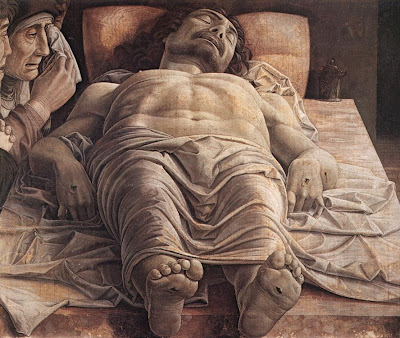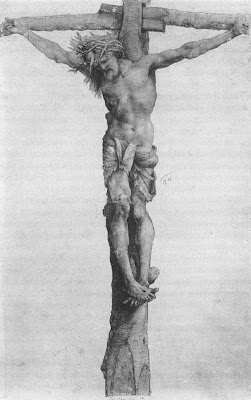
Mantegna's "Dead Christ" is, in my opinion a turning point drawing in the development of Reanaissance art. Mategna was a most draughtsmanly painter. This work is done in tempera on canvas and was completed around 1490. It measures 46 x 81 cm so is roughly A1 size. In the years when I was a life model at the art faculty in UCLAN in Preston there would always be a time when I did this pose. It was a favourite for it gives a classic lesson in foreshortening.
It was one of the more relaxing poses in a life class. The pose usually lasted all day, I don't suppose I would have been a "dead" figure but if I'm honest, I will have certainly been a sleeping one!
Drawing the foreshortened figure from life is a good exercise, it forces you to abandon preconceptions about what the human form looks like. You have to draw what you see, not what you think you ought to be seeing.
.jpg) Ερμαφρόδιος Hermaphrodite, one of a series of drawings using various media, - this one in watercolour with the figure drawn with a graphite stick, - taken from a sketchbook image I made when last in Larnaca. The original statue has the left leg broken off at the calf. In the sketchbook version I added the missing component but in the series of finished works I decided otherwise. I am coming to realise that part of the aesthetic to modern 21st century eyes is this ancient statuary in its incomplete state. It makes us appreciate what remains and in that way make a link with artists of the past.
Ερμαφρόδιος Hermaphrodite, one of a series of drawings using various media, - this one in watercolour with the figure drawn with a graphite stick, - taken from a sketchbook image I made when last in Larnaca. The original statue has the left leg broken off at the calf. In the sketchbook version I added the missing component but in the series of finished works I decided otherwise. I am coming to realise that part of the aesthetic to modern 21st century eyes is this ancient statuary in its incomplete state. It makes us appreciate what remains and in that way make a link with artists of the past. Some of the series here on my studio walls.
Some of the series here on my studio walls.
.jpg)
